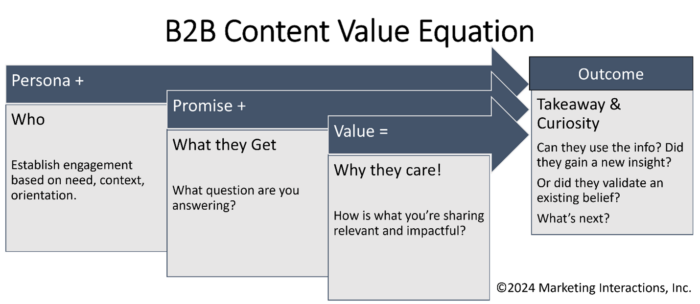
Value. It’s become a buzzword of little…value. What does it mean to B2B buyers? Often, companies think of value in relation to their business — more so than for their customers. They think it lives within the features of their products.
As marketers, we’re told our content and buyer experiences must deliver value. We tell sellers they must deliver value in their conversations with buyers. But have we stopped to think about what this term “value” means from our buyers’ perspectives? Or have we failed to link strategy to execution?
Forrester defines customer value as what they get versus what they give up in the pursuit of a goal.
What your customers get is not your product, it’s the outcome made possible from using your product. It’s about them, not you. They are the heroes. You and your product are merely the assistant.
But here’s the tricky part. There are outcomes all along the treacherous path of the B2B buying journey. Your buyer must perceive each experience with you as valuable or you risk your buyer taking an offramp toward another option they see as more valuable than yours.
You must understand the definition of value relevant to your target segment or persona. Contextualize your content and interactions based on buyer needs, challenges, preferences, and perceptions. And remember, each persona involved in the deal may perceive value differently.
The most important note here is that we don’t define value, our buyers do. We can yell from the rooftops that you’ll get an 85% improvement in productivity and point to our customers who have achieved that, but if your buyer values cost reduction over productivity, how valuable is that cherished statistic?
The Flavors of Value for B2B Buyers
Let’s dive into this conundrum of value and how to tackle it to build momentum in buying cycles.
Buyers perceive value as incremental until it grows to a tipping point that has your buyer decide they need what your product offers. And that the risk they’ll take to get that outcome is worth making the choice to buy.
Think about the ways value shows up for buyers:
In the awareness stage, it could be your article exploring the problem your buyer is dealing with that provides them with useful insights that guide them to consider whether the problem is worth solving–along with the tradeoffs from choosing not to solve it.
Now that you’re on the buyer’s radar, they attend a webinar where they learn about the advantages one of your customers realized that were unexpected which helped them get a return on their investment faster than they’d forecast.
Because the buyer is now in your database, you send them a checklist to evaluate the benefits of solving their problem that includes practical considerations that help them spark conversations internally to drive consensus about the urgency of acting sooner, rather than delaying the decision.
As you can see, value is not only in those statistics we all chase after to plaster on our websites and in our case studies, it’s found in the experiences your buyers have when they engage with our ideas, guidance, and expertise that build their perception of how valuable you and your products could be to them.
Value Becomes Even More Critical with Self-Driven Buying
Gartner research reveals that 75% of B2B buyers prefer a rep-free sales experience. But the analyst firm also finds that self-service purchases are likely to result in purchase regret.
When working to contextualize value, it’s important to remember the “invisible” value that plays a role. Self-confidence is an example. So is trust. It’s important to consider these personal attributes and factor in how your content and experiences help build both as a takeaway for your buyer.
In all the years I’ve been a marketing strategist, this is the biggest opportunity I’ve seen for a long time.
Buyers want to self-educate. But they don’t know what they don’t know. I was on a persona interview call last week when a customer said they’ve been in their career for 20+ years but this is the first time they’ve purchased a solution like what my client sells. Why? Because the technology didn’t exist before. He also said it may be the only time in his career that he implements this type of solution.
On the flip side, Millennials are also moving up to positions where they’re in charge of buying big, complex solutions for the first time in their careers. Do they understand how the business operates and what’s important given their company’s go-to-market strategy? Do they have relationships with the others on the buying committee to gain consensus given the certainty of different levels of experience and expertise involved?
Think about that. At the rate of change, what’s the likelihood that a buying committee has the experience of having done this before with the features and functionality available today? In addition, it’s not just technology that’s changed, it’s the entire market environment. It’s the different ways we’ve come back up to speed after the pandemic. It’s a lot of things.
In another persona call recently, when I asked the customer what they wished they had known before they purchased, she said the necessary steps and potential disruption possible during implementation. Complex solutions are not plug and play — not for the most part.
- What are the steps they need to prepare for?
- What in their current situation must they address before the new system comes on board?
- What skillsets and expertise will need to move off their current job to do this work?
- Do they even have the skillsets on staff needed to do the work?
- What could go wrong if they attempt to implement prior to doing that work?
Value must be present during all stages of buying… and the customer lifecycle. It’s our job to uncover the questions they need answered to get to that tipping point of value. And equally important for building loyalty and advocacy after the fact. The goal is to maximize confidence and trust and minimize regret.
Construct a B2B Content Value Equation to Drive Momentum
Let’s return to a key point made earlier: Value builds incrementally until it hits a tipping point for buying.
So, how do we build a strategic content marketing strategy to accomplish this?
We build a value equation that helps us plot the path.

The value you deliver to your buyers via the content you provide is directly related to how well you know and understand your buyers. In a world where ChatGPT is spewing out variations of everything that’s been said about topics in the past, it’s your goal to address what’s new, what’s different, and what’s coming. But, to do so, you need to understand where your buyer is starting from. And that requires well-built personas that delve into the entire buying experience.
Otherwise, what are you basing the context of the content on? And how will you know what questions to answer in a way that’s providing an outcome they value?
The other key concept to the content value equation is there are no dead ends. This is where the strategic part comes in. You need to build the story to build momentum. Given what they just learned or validated given the content they viewed, what should they do, learn, or verify next?
I usually create these buyer-driven storylines in spreadsheets so I can see the progression for each content asset horizontally and gauge the momentum of the storyline vertically, as it builds. I also want to verify the focus of the story is on problem to solution with a consistent throughline.
It’s important to think across channels but you must remember to connect the content across them to help your buyers self-serve the content they need to gain momentum as they go.
Finally, this is not a static plan. Things change. So do your buyers. The beauty of it is when a new question comes up, you can slot it into the progression and if an existing question is no longer valid, you can remove it. There’s infinite flexibility in the structure of the equation. It’s all in how you tell the most relevant story that delivers value to fuel momentum.
Building trust requires continuous moments of experienced value. Trust is cumulative, not based on any one moment. You gain or regain trust with every interaction across the continuum of the relationship with your buyers/customers. As you’re growing trust, you’ll find a higher level of willingness for buyers to act on what you ask. If they’ve had valuable experiences with you before, they’re more willing to fill out a form for gated content, for example, because they “trust” the download will be valuable and relevant—as promised.
Ensure Buyer-Driven Experiences Deliver Value
As I’ve said, the opportunity for B2B marketers to capitalize on the self-serve trend for buyers is huge. They still need help no matter how much information is at their fingertips. Many buyers have difficulty finding content they’d rank as valuable. But they want it. They need it to build confidence that they’re making the right choice.
Companies need to provide value to drive growth. Sales cycles are lengthening and at least half of deals result in no decision. Building a B2B Content Value Equation provides an opportunity to engage more buyers, build their confidence, and get your company on the shortlist. Buyer experience research finds that 83% of buyers initiate first contact and that they’ve made their decision by the time they get in touch.
With a genuine curiosity to get to know and understand your buyers and customers — in their context, not yours — you’ll know what’s valuable to them. Once you understand that, the sky’s the limit for creating strategic content marketing programs that have your sales reps in more conversations with knowledgeable buyers who’ve put you on their Day One list and show up ready to buy if everything they’ve learned proves out.
Delivering perceived value that incites momentum is a tall order. B2B marketers who build their foundation of buyer knowledge well are up for the challenge.



